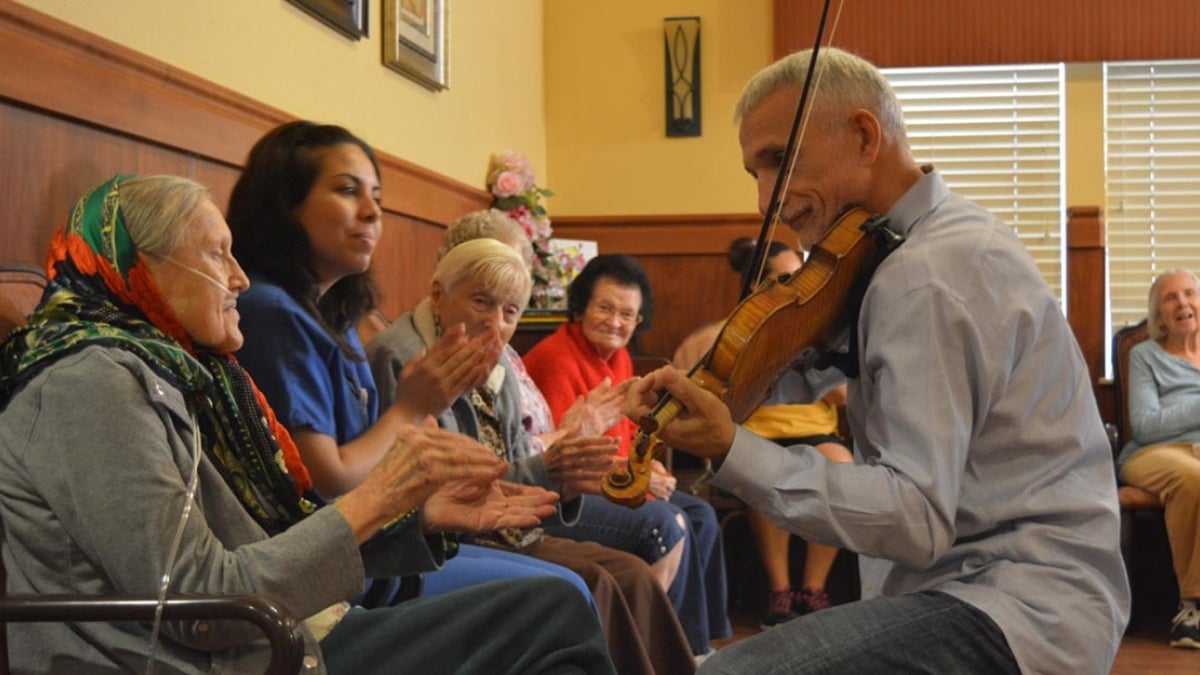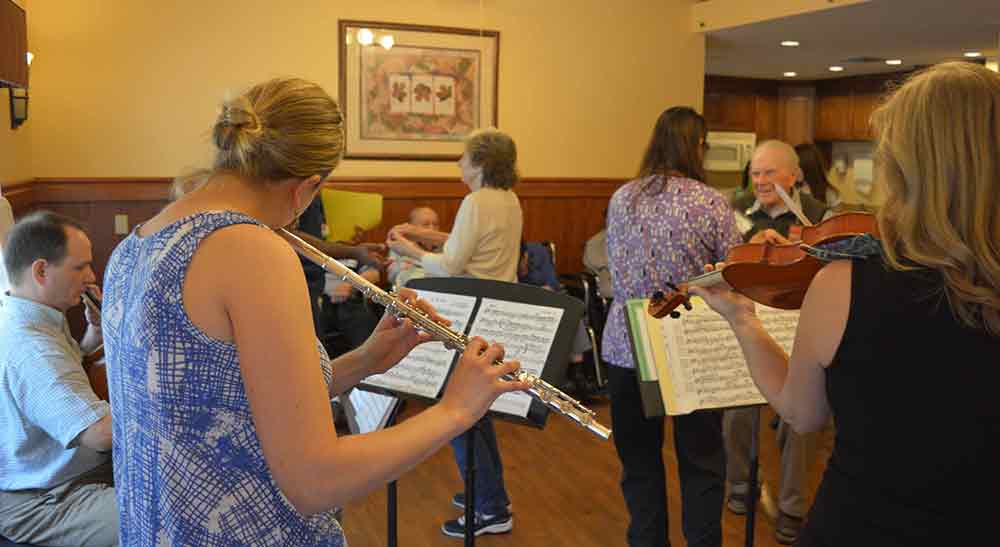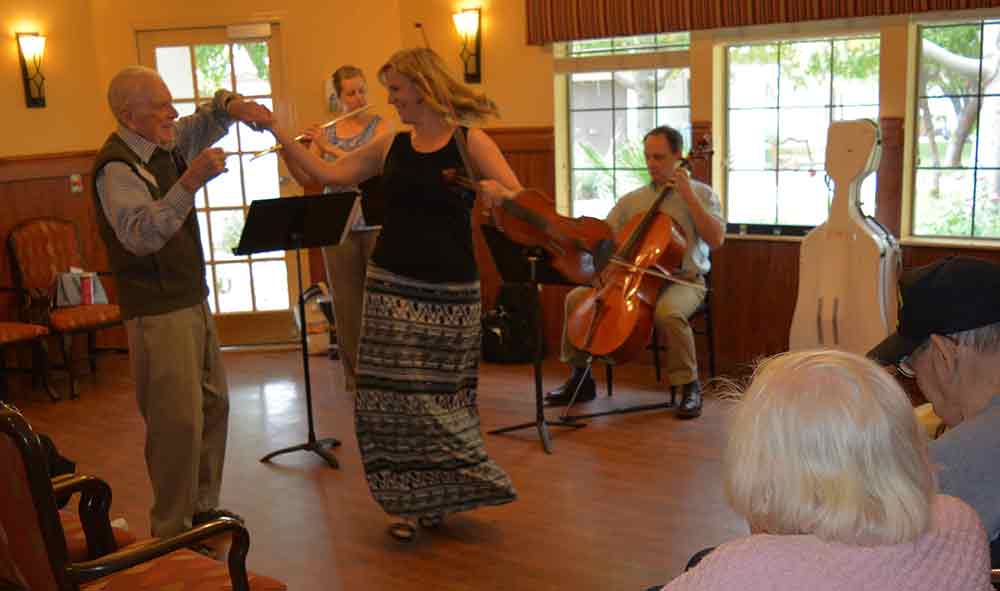A violinist bows an expectant note as she tunes her instrument alongside other Phoenix Symphony musicians. They assume the “ready” position, waiting for the cue to begin.
The small group sitting before them in a semicircle is a somewhat unique audience: It is made up of men and women living with Alzheimer’s disease or other forms of dementia, their professional caregivers and a few family members. They are participants in Arizona State University’s Music & Memory project at the Huger Mercy Living Center, an assisted-living facility in Phoenix.
The musicians begin their piece, an energetic and upbeat melody. Some of the men and women clap along to the lively tune as music fills the room. Others, at first, look past the performers as if they are not there.
As the concert continues, the musicians vary the repertoire with pieces that are triumphantly loud or quietly meditative. Soon, even the people who seemed unaware of the performance become actively engaged.
Music can help people living with Alzheimer’s connect to long-term memories and emotions in a positive way, according to David Coon, associate vice provost and professor in ASU’s College of Nursing and Health Innovation.
“Music is capable of improving the quality of life of individuals with dementia, even at the end of their life,” said Coon.
Or as one family member eloquently states: “Music is the key to their memory door.”
Listening to music can also be a positive experience for the loved ones and caregivers of people living with Alzheimer’s, who can be under a great deal of stress. Family members described music as a shared experience and a vital communication tool across the trajectory of Alzheimer’s. “Music is the guide in many ways ... for them, for us or for anyone,” one of them noted.
Photos courtesy of the Phoenix Symphony.
The power of music to evoke emotions and memories and to ease suffering is at the heart of the Music & Memory project, a partnership between ASU health and music therapy researchers, the Phoenix Symphony and the Huger Mercy Living Center. It is one of several medical humanities efforts at ASU that bring together experts from health-related fields, arts and humanities to create new types of care and outreach that have a profound impact on people’s lives.
Coon leads the Music & Memory project with colleagues Robin Rio, director of the ASU Music Therapy Clinic in the School of Music in the Herberger Institute for Design and the Arts, and Marianne McCarthy, associate professor in the College of Nursing and Health Innovation.
In the beginning of the project, the musicians performed planned selections, but progressively the music became more improvised and responsive to the residents. From fight songs to hymns to complex classical pieces, the musicians took cues from the residents about what music to play. When someone requested a polka, the performers readily complied.
The study evaluated the effect of live music on the moods of residents, caregivers, musicians and loved ones before and after performances. The caregivers, musicians and loved ones rated their own moods, while a nurse or activity coordinator evaluated the residents.
In addition, researchers collected saliva samples from participants before and after some symphony performances. Scientists from ASU’s Institute for Interdisciplinary Salivary Bioscience Research analyzed these samples for known biomarkers of stress, giving further insight into the effect of music on mood.
As Alzheimer’s advances, a person needs help with even the most personal tasks, such as bathing. This can be stressful for both resident and caregiver. Knowing this, the researchers used bathing as an event for assessing stress levels. They collected saliva samples before and after bath time on days with and without a symphony performance.
Their results indicate that listening to live music improved the mood of people living with Alzheimer’s immediately after performances and also likely helped to ease stress at other times, such as during a bath. The moods of musicians, caregivers and loved ones were also more likely to be positive after a performance. The musicians said the project left a profound impression on them both personally and with regard to their music.
Watching the performances, Coon witnessed the emotional impacts firsthand. For example, he remembers one couple getting up to dance to “their song.”
Another time, a friend of one of the residents entered the room during a performance, but paused when he saw his friend actively engaging with the music.
With tears in his eyes, the man said to Coon, “I haven’t seen [my friend] like this in five years. He is alive and connected in a way that I haven’t seen in five years. I’m going to leave and not let him know I was here today, because I want him to stay in this moment and not be pulled into a moment with me.”
More Health and medicine
ASU team part of nationwide study looking at Type 2 diabetes in youth
Near the end of an interview in which he talked about the work his team will be doing to tackle the rise in Type 2 diabetes among youth, Arizona State University Professor Gabe Shaibi answered why…
Leading the way in wellness: ASU highlighted in The Princeton Review's 2025 Mental Health Services Honor Roll
Being a college student isn’t easy — navigating new routines, people and places can be a challenge, especially if the right support system is not in place. That's why Arizona State University is a…
New Indigenous health dashboard offers robust database for scholars
By Nicole Greason and Kimberly Linn A team at Arizona State University’s College of Health Solutions and American Indian Studies program has created a new tool to aid researchers…


